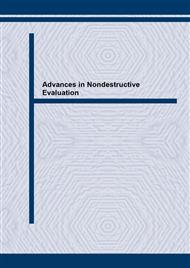[1]
M. Sansalone and N.J. Carino : Impact-Echo: A Method for Flaw Detection in Concrete Using Transient Stress Waves (Report No. NBSIR 86-3452, National Bureau of Standards, Washington, D.C. /PB 87-104444/AS, Na. Tech. Inf. Service, Springfield, Virginia, Sep. 1986).
DOI: 10.6028/nbs.ir.86-3452
Google Scholar
[2]
M. Sansalone and N.J. Carino: Detecting Honeycombing, the Depth of Surface-Opening Cracks, and Ungrouted Ducts Using the Impact-Echo Method, Concrete International, V. 10, No. 4, (1988).
Google Scholar
[3]
S.P. Pessiki and N.J. Carino: Setting Time and Strength of Concrete Using the Impact-Echo Method, ACI Materials Journal, V. 92, No. 6, Sep. -Oct. (1988).
Google Scholar
[4]
S.K. Mantrala and C. Vipulanandan, Nondestructive Evaluation of Polyester Polymer Concrete, ACI Materials Journal, V. 92, No. 6, Nov. -Dec. (1995).
Google Scholar
[5]
S. Pessiki and M.R. Johnson: Nondestructive Evaluation of Early-Age Concrete Strength in Plate Structures by the Impact-Echo Method, ACI Materials Journal, V. 93, No. 3, May-Jun. (1996).
DOI: 10.14359/9811
Google Scholar
[6]
KS F2437: Resonance Vibration Testing for Dynamic Modulus, Shear Modulus and Poisson's Ratio of Concrete (Korea Indutry Promotion Governmemnt Office, 1990).
Google Scholar
[7]
ASTM C215-91: Standard Test for Fundamental Transverse, Longitudinal, and Torsional Frequencies of Concrete Specimens (Annual Book of ASTM Standards, V. 04. 02, 1991).
Google Scholar
[8]
F.E. Richart, R.D. Woods, and J.R. Hall: Vibrations of Soils and Foundations (Prentice-Hall, Inc., Englewood Cliffs, New Jersey, 1970).
Google Scholar


